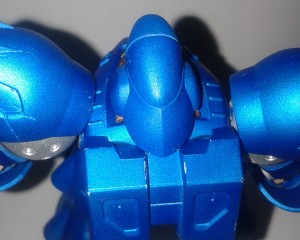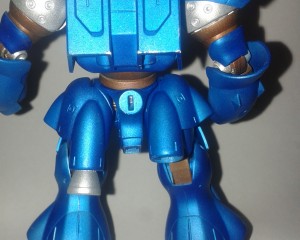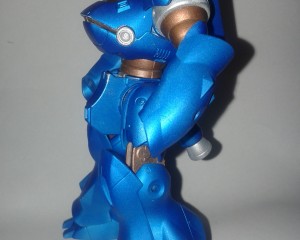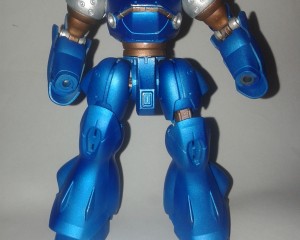-
Jaberwak posted an update in the group
 Q/A & Help Group 8 years, 6 months ago Problems with chipping paint.
Q/A & Help Group 8 years, 6 months ago Problems with chipping paint.
Was doing some paint tests and come up with this big problem. Paint is chiping like crazy if i touch it, blow air at it (and i dont mean from the airbrush ^^) and so on… You can see it on the pictures.
The paint i used (in the layer order). Primer (vallejo 74.600) , Tamiya X-11 (thined 50:50 with isopropyl 97%, a pinch of acrylic retarder), then the vallejo transparent blue (8-24h after the chrome silver) 70.938 thined 50:50 with isopropyl. I let it cure for 6 hours.
Put the parts together and just put it on shelf (just to few aligator clips to get all the painting done in one go ^^) The next day lots of small paint chips started to appear. So the question is. What did i do wrong?




did u top coat it becasue thats the usual main cause top coat it wth some future becasue that stuff is resistant to almost everything plus its cheap
Havent topcoated it yet. It might have been my mistake. Also notice that the paint is chiping from places that have no mechanical connection like the top of the shoulders. Ill try fixing it by handbrushing and then topcoating it with gloss varnish. Question. Will it lose the metalic paint effect if i do that?
I don’t know if I’m seeing this right, but in the middle and the right edge on the top of the backpack, is the primer actually coming off?
I’ve heard that some modelers had problems with the Vallejo primer. It’s recommended NOT to thin it, spray two light coats and a final covering coat with a drying time of at least a half hour between them and then letting it cure for at least 24 hours at room temperature. And when planning to sand, a 48 curing period.
But I’m assuming you did this and as far as I can see, the paint is chipping off at other parts and leaving the primer still on the model.
If only the blue is coming off, the problem is most likely that you thinned the Vallejo transparent blue with iso. alcohol. This is fine for Tamiya and Mr.Hobby, but Vallejo needs to be thinned with Vallejo thinner or demineralized water.
If the Tamiya X-11 is also coming of, the problem is the primer.
And for your last question, you can spray a gloss on top of the paint and keep a metallic look. In the automotive industry this is a normal thing to do. We even bring on two coats of a gloss to coat. This gives a brighter deeper sheen.
Your best option now is to tip some paint on where it has come off. Then put a gloss top coat on top of it. To be sure the finish doesn’t get messed up, use a Vallejo top coat on it. Since your last coat is a water based paint, don’t use a alcohol, enamel or lacquer based top coat. It may eat trough the blue. And please keep in mind, Vallejo top coats, as well of the normal paints, are really weak. Best of luck
The primer somehow holds…(the orginal color of the kit is dark purple) I know some modelers have problems with this primer. Im also in love/hate relationship with it. Love it for the ease of use and as long as it covers the part it works great. Hate it cause you just cannot sand this primer cause its kind of rubbery and doesnt eat into plastic. Tamiya paint stays well so i guess you might be right about vallejo and alcohol. Gonna get demineralized water tomorrow and do some tests on the rest of the parts.
I know Vallejo paints are weak. But they one of the easiest paints to work with and they have lots of colors variations (im kind of weak at paint mixing to get the right color)
*the primer holds on most parts. There are two places that came a bit off. Hopefully the fixes will hold.
Yeah, I know, mixing paint can be a pain in the butt. Maybe a tip, I use the paint mixing bottles from Vallejo. They are 30/35 ml. Then pore some alcohol in them to level out the bottom (they are spherical). I use a toothpick as a measure stick. For instance a 80/20 percent mix, if I don’t need much paint, I carve 1 cm on the toothpick. 80 percent of 1 cm is 8 mm. Then I carve that on the toothpick and fill the jar up to that point. The rest is filled with the 20 percent of the other color. To fill the color, I often use a straw, dip it in the paint and put a finger on the upper end. hold it in the jar and lift off the finger. The paint then “falls” into the jar. The straw technique even can be used to get the mixture somewhat right. Filling the straw with paint and then 80 drops of one color and then 20 drops of the other, for the example in this case. Just make sure as the jar of paint gets more empty, to tilt it ever so slightly, so the level of paint in the straw keeps the same, or else your mixture will be of. Hope this helps.
In any case, I hope the patching up goes well. Best of luck
did you clean the plastic with water and liquid detergent or anything alike before painting?because their are some residue from molding the plastics (like oils, etc.) that make the paint can’t adhere so much.
Plastic was cleaned. Its just the last layer of paint pealing off. Didnt have time to check with demineralized water as tete sugested yet (had a rather hectic end of week in work) but i guess it could be the main culprit.